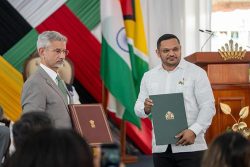Just days before the fourth anniversary of his government in office, President Irfaan Ali expressed pride in the government’s housing programme. “We did not just commit to building 50,000 house lots, we are delivering it,” Mr Ali stated.
According to the President, the housing initiative has already provided access to homes for over 35,000 Guyanese, with an investment exceeding $240 billion.
To complement the creation of 35,000 house lots and homes, the government, he said, has constructed 414 kilometres of new roads, laid 250 kilometres of water transmission mains, and installed 2,200 kilometres of electricity transmission lines. These improvements are integral to ensuring that new housing schemes are well-supported and sustainable, the President said.
Further, the average cost of a low-income home has been reduced to $4.2 million, with interest rates cut by 2.5%. Additionally, housing loans have increased by 18% and now stand at $56 billion.
Over 3,000 houses have been built, including 1,000 low-income homes costing $5.9 billion, more than 400 moderate-income homes, and 100 middle-income homes, the President said. Additionally, 1,000 homes have been allocated to young professionals, and vulnerable populations have been supported with core homes. Investments have also been made in hinterland housing, totalling $2 billion, benefiting many in remote areas. Furthermore, 16,000 individuals have gained from mortgage relief amounting to more than $2.8 billion.
The developing of 35,000 house lots and the building of 3,000 houses – some given to vulnerable families – is a great achievement for any government and President Ali’s administration should be given full credit. For context, it is also worth pointing out that oil revenues – flowing since 2019 – have now enabled massive expenditure as reflected in the astronomic growth in budgets over last three years. Indeed, the last two budgets have seen the inflow of an average of just over US$1b per year in oil revenues when for decades the country had suffered from the albatross of an external debt of US$2.1b.
There is one other aspect of the President’s assertions that require deeper examination and that is the question of accountability and transparency. It may very well be the case that 35,000 house lots are being developed or have been developed and 3,000 houses built. However the public is being asked to take this all on trust. Perhaps President Ali’s government would be sufficiently confident of its achievements over the last four years to subject these figures to broader examination.
This is certainly the type of work that the Economic Services Committee of Parliament could and should take on; a bipartisan group examining what is a programme of major financial disbursement would be a seminal manifestation of what had been envisaged by constitutional reforms of 1999 to 2001. A representative sample of house lots could be visited by the committee to determine what has happened over the four years of allocations, how much construction has begun on the lots, is the construction sound, are the lots serviced by adequate infrastructure and have any of the lots changed hands? A sizeable budgetary allocation to the committee would certainly be required to accomplish this and questions have already been raised as to whether these parliamentary committees are adequately resourced to execute substantial tasks that might be assigned to them.
Whenever elections are held next year, President Ali’s government will be called upon to show evidence of its accomplishments based on its 2020 manifesto promises. The biggest one, of course, is the promise to create 50,000 jobs. This promise has already seen President Ali say that the target has been met and exceeded. Making grand promises can never be so easily resolved and vetted. Unless President Ali is prepared to have his claim subjected to an examination of the type mentioned above it will have little to no credibility. Several thousand jobs have been created by ExxonMobil and its sub-contractors since 2015 and the government could plausibly lay claim to the ones added from 2020. However, aside from this, the number of jobs created by this administration is debatable. Rehiring in the sugar industry and the boom in the construction sector would have accounted for several thousands but these numbers are far away from 50,000 and the so-called 10-day jobs do not count. Anecdotally, in its visits to all parts of the country in its cost of living series, Stabroek News has encountered the constant lamentation about the unavailability of jobs. The level of unemployment in these communities continues to be high.
Now in the fifth year of its term, the government faces the moment of truth on its prestige projects: the new bridge over the Demerara River and the most expensive public sector undertaking in the nation’s history: the gas to energy project.
As it relates to infrastructure – whether drainage, roads or other sectors – there have been clear problems that impinge upon the quality and timeliness of work and which raise concerns about corruption and malfeasance. While undoubtedly qualified and competent contractors have delivered large tasks on time and within budget other projects have encountered difficulties. What percentage of the projects in terms of quantum and value have foundered is unclear and is again a matter ripe for considered examination by some oversight body.
Answering questions in Parliament on Wednesday, Minister of Public Works Juan Edghill disclosed that there had been an “amicable” end to the Conversation Tree contract with Trinidadian company Kallco which entailed the ministry taking possession of $153m worth of its vehicles and equipment. That project was a patent failure and should have resulted in the termination of the contract and legal action to reclaim advances in addition to the impounding of the equipment. Will this decision have to eventually be examined by the Auditor General’s office or the Public Accounts Committee which Mr Edghill currently sits on? What were the grounds for the “amicable” settlement and is this dispensation available to any and everybody? The Cemetery Road project delay is another example where there should already have been a cancellation but it does appear that some contractors are favoured over others.
President Ali’s government also has to be accountable for the award of large projects to the unqualified such as the Bellevue pump station contract to Tepui Inc whose principal, unqualified for the job, has easy access to circles of PPP influence so as to suggest cronyism at best. The procurement system under the Ministry of Finance is evidently riddled with potholes.
On the gas to energy scheme, the metrics applicable would be whether the project is delivered as planned and whether it can actually halve the power cost to electricity users. One can predict that given the high-stakes promise made by the PPP/C that power bills will be cut in half before the elections are held. The question will however remain: has there indeed been a cut by 50% in cost? This is what will again have to carefully examined by independent financial experts who can cost the project precisely against the current heavy fuel oil generators.
The gas to shore project aside, President Ali’s government stands indicted for enabling ExxonMobil and Co. to gorge on Guyana’s resources without even an inflexion towards improving the disastrous deal bequeathed to the country by the APNU+AFC government in 2016. The fifth anniversary of oil production is approaching and finds the country without a regulatory commission and negligible defences against an oil spill in the Atlantic.
The runaway spending by government as evidenced by the turbo-charged budgets with supplementary expenditure on top of that and unending subventions to a sugar industry that does not seem to be turning around are other areas that will prove stern tests for the Ali administration. Next year will be exceedingly interesting.




